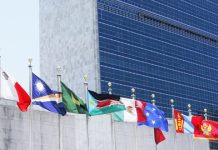Observed annually on 1 December, the World AIDS Day serves as a reminder of the global fight against the pandemic while commemorating lives lost and celebrating progress.
“Every 25 seconds, someone in the world is infected with HIV,” Mr. Guterres said.
“One-quarter of people living with HIV – more than nine million people – lack access to lifesaving treatment,” he added.
He called for a rights-based approach to human immunodeficiency virus (HIV) prevention and treatment, highlighting the harmful effects of discriminatory laws and practices that stigmatize women, girls, and minorities.
“The fight against AIDS can be won,” Mr. Guterres stressed, “If leaders take a rights-based approach to ensure that everyone – especially the most vulnerable – can get the services they need without fear.”
“We will overcome AIDS if the rights of everyone, everywhere, are protected. I call on all leaders to heed this year’s theme and take the ‘rights’ path,” he declared.
Keep rights at core
UNAIDS, the Joint UN Programme on HIV/AIDS, reinforced the call, urging governments to “take the rights path to end AIDS.”
Winnie Byanyima, UNAIDS Executive Director, stressed the importance of removing systemic barriers to healthcare.
“To protect everyone’s health, we need to protect everyone’s rights,” she said.
Progress at stake
Its World AIDS Day report showed that respecting and protecting human rights can help ensure equitable access to HIV services and prevent new infections.
It also revealed how gaps in realization of human rights, and abuses and violations obstruct the end of the AIDS pandemic.
The UNAIDS report underscores that progress will stall without a human rights-based approach. In 2023, 1.3 million people were newly infected with HIV globally, three times the target of no more than 370,000 annual infections set for 2025.
Women, children at risk
In addition, 63 countries still criminalize LGBTQ+ people, while widespread gender-based violence and limited educational opportunities for women and girls leave them particularly vulnerable.
Last year, they accounted for 62 per cent of new HIV infections in sub-Saharan Africa. Worse still, nine out of ten new infections among 15 to 19-year-olds are among girls, reflecting systemic gender inequalities, according to UNICEF.
The disparity is also evident in access to treatment, including for boys and young men.
While 77 per cent of adults living with HIV have access to antiretroviral therapy (ART), only 57 per cent of children aged 0 to 14, and 65 per cent of adolescents aged 15 to 19 do.
“Children and adolescents are not fully reaping the benefits of scaled up access to treatment and prevention services,” said Anurita Bains, UNICEF Associate Director of HIV/AIDS.
“Children living with HIV must be prioritized when it comes to investing resources and efforts to scale up treatment for all, this includes the expansion of innovative testing technologies,” she added.
Source of original article: United Nations (news.un.org). Photo credit: UN. The content of this article does not necessarily reflect the views or opinion of Global Diaspora News (www.globaldiasporanews.net).
To submit your press release: (https://www.globaldiasporanews.com/pr).
To advertise on Global Diaspora News: (www.globaldiasporanews.com/ads).
Sign up to Global Diaspora News newsletter (https://www.globaldiasporanews.com/newsletter/) to start receiving updates and opportunities directly in your email inbox for free.































